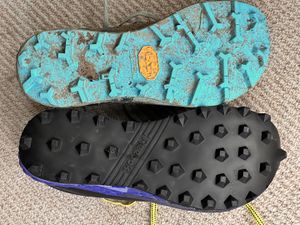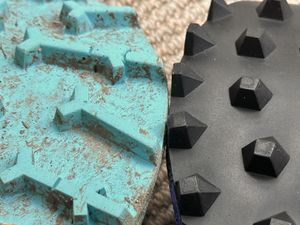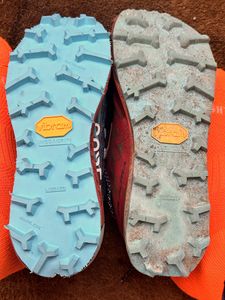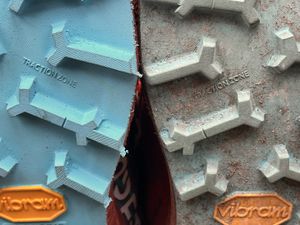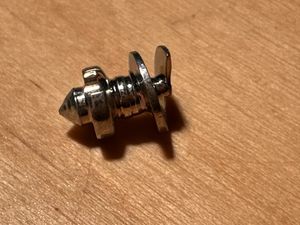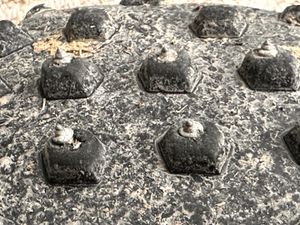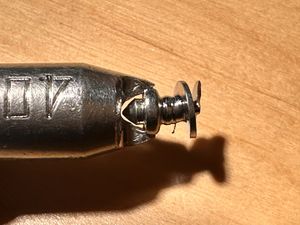Difference between revisions of "Frankenshoes"
User:Fellrnr (User talk:Fellrnr | contribs) |
User:Fellrnr (User talk:Fellrnr | contribs) |
||
| (One intermediate revision by the same user not shown) | |||
| Line 11: | Line 11: | ||
</gallery> | </gallery> | ||
==Cheshire Shoe Repairs and Reebok Studs== | ==Cheshire Shoe Repairs and Reebok Studs== | ||
| − | Cheshire Shoe Repairs provide a variety of outsoles, and I've used their "Pyramid Cross Country", which is labelled as Reebok on the outsole. It's | + | Cheshire Shoe Repairs provide a variety of outsoles, and I've used their "Pyramid Cross Country", which is labelled as Reebok on the outsole. It's an 8mm stud and provides good grip on most surfaces. It's good on soft mud and most rocks, though it fails on some slick rock. It's surprisingly okay on concrete or asphalt, but that's not its forte. You can add metal spikes for winter running (see below), though it's awkward to get the spikes into the studs. The studs don't last as long as the rest of the shoe, and as the studs round off, the traction is reduced more than you might expect. (I've not been able to find this sole other than at Cheshire shoe repairs in the UK.) https://www.cheshireshoe.co.uk/running-shoes-resoles-repairs/ |
==The Key Cobbler Kendal and Vibram Peak District== | ==The Key Cobbler Kendal and Vibram Peak District== | ||
| − | The Peak District outsole has 8mm lugs in a dog bone pattern. I've found this outsole to be as | + | The Peak District outsole has 8mm lugs in a dog bone pattern. I've found this outsole to be as better than the Reebok outsole on all surfaces and is much harder wearing. There are some slick rocks where it doesn't grip, but that's rare. Compared with an Inov8 MudTalon sole, this vibram outsole is far better on every surface. The main downside is that you can't get metal spikes into this outsole as the lugs are too narrow. (Another downside is the cost compared with the Reebok, but prices have increased over the last few years for both.) [https://keycobbler.co.uk/collections/running-shoe-repairs https://keycobbler.co.uk/collections/running-shoe-repairs] |
| + | ==Vibram Peak District Longevity== | ||
| + | Below are photos of a pair of Altra Lone Peak shoes after around 1,000Km (600 miles). After this much distance, the midsole foam had compressed enough to make them useless, and the upper had started to split, probably after contact with a sharp rock. As you can see, the Peak District sole is virtually unchanged. There's no reduction in grip on any surface, and the lack of wear on the outsole prevented me from realizing how worn out the shoes had become. Most of the distance has been on rocky or muddy trails, with a bit of road running to get to the trails. | ||
| + | <gallery widths=300px heights=300px class="center"> | ||
| + | FrankenShoe Life1 (Large).jpg| The shoe on the left has a new Peak District sole, and you can see the colour has changed. | ||
| + | File:FrankenShoe Life2 (Large).jpg| A close up shows the surface pattern has rubbed off, and the edges of the lugs are not quite as crisp. But after that distance, it's remarkable how little wear there's been. | ||
| + | </gallery> | ||
==Vibram Zegalite and Vibram Zegama== | ==Vibram Zegalite and Vibram Zegama== | ||
I've not tried either of these outsoles, as the Zegalite is only 4.5mm and the Zegama is only 4mm, which isn't much different to a standard trail running shoe. They are available at a number of cobblers in the UK. | I've not tried either of these outsoles, as the Zegalite is only 4.5mm and the Zegama is only 4mm, which isn't much different to a standard trail running shoe. They are available at a number of cobblers in the UK. | ||
| Line 27: | Line 33: | ||
</gallery> | </gallery> | ||
==Screw in or Slip On?== | ==Screw in or Slip On?== | ||
| − | The alternative to screw in metal spikes is to have an overshoe that has additional grip. Common brands include Yaktrax or Kahtoola exospikes, and I've used both. The advantage of the screw in spikes is they work in all conditions, and the additional grip can be handy on some surfaces even in summer. The screw in spikes add little weight and are always there. Overshoes are relatively heavy, and have to be put on when needed, and that can be hard if the weather is cold. Stopping to put overshoes on snow covered shoes with cold hands is a grim experience sometimes. I've also had problems on mixed surfaces, where there's exposed rock and ice with Yaktrax falling apart. Overshoes are also heavy and bulky to carry, so I've given up on mine completely, and prefer screw in spikes. (If you need crampons, then you need crampons, and spikes won't help. I have Kahtoola microspikes, which are a half way to crampons that work with running shoes, but rarely use them as I don't like running when things are that bad.) | + | The alternative to screw in metal spikes is to have an overshoe that has additional grip. Common brands include Yaktrax or Kahtoola exospikes, and I've used both. The advantage of the screw in spikes is they work in all conditions, and the additional grip can be handy on some surfaces even in summer. The screw in spikes add little weight and are always there. Overshoes are relatively heavy, and have to be put on when needed, and that can be hard if the weather is cold. Stopping to put overshoes on snow covered shoes with cold hands is a grim experience sometimes. I've also had problems on mixed surfaces, where there's exposed rock and ice with Yaktrax falling apart. Overshoes are also heavy and bulky to carry, so I've given up on mine completely, and prefer screw in spikes. (If you need crampons, then you need crampons, and spikes won't help. I have the Kahtoola microspikes, which are a half way to crampons that work with running shoes, but rarely use them as I don't like running when things are that bad.) |
| + | =Converting road shoes for technical trails= | ||
| + | I have converted a few road running shoes for technical trail use with mixed results. Other than the outsole grip, the main difference between a road and a trail shoe is how well the upper grips your foot. I've put the pyramid outsole on the Altra Torin which produced a remarkably comfortable shoe that has excellent traction and works really well for nontechnical trails. But when things get gnarly, the shoe isn't close fitting enough to give the agility you need. Converting a road shoe that has a Pebax foam midsole creates a hybrid that works reasonably well on hard, relatively smooth trails. The trails need to be close enough to asphalt for the bounciness of the pebax foam to work. On trails that are even vaguely technical, the bouncy foam becomes unstable and creates significant additional ankle stress. Of course, if you're on a course that transitions between easy, firm, trials and asphalt, then the Pebax foam might work well. | ||
Latest revision as of 11:26, 6 May 2024
A Frankenshoe is where the outsole of a shoe has been replaced, creating a shoe with better characteristics. This is different to where the outsole has been replaced simply to extend the life of a shoe. The goal with a Frankenshoe is to create an entirely new shoe, and often the outsole is replaced on a new shoe before any wear. This is typically done to put a more aggressive trail outsole onto a shoe that lacks traction. This can even be putting a trail outsole onto a road shoe.
Contents
[hide]1 Advantages of the Frankenshoe
The advantage of a Frankenshoe is the ability to have a shoe you like with an outsole that suits the terrain. For instance, I love Altra shoes, but they don't make a trail shoe with large studs for running on steep, soft ground. Another advantage can be that the replacement outsole is stiffer than the original, which provides more protection from rocks and stones.
2 The downsides of the Frankenshoe
The two big downsides are cost and weight. Having a shoe resoled in the UK costs between £40 and £65 ($60 and $100, early 2024 prices). I think this is well worth the cost, as it produces a shoe that I couldn't have any other way but is still rather painful. The new sole will typically add weight, but how much depends on the weights of the old and new outsoles. The resoling involves sanding down the old outsole to form a flat surface to glue the new outsole to. I measured the Reebok outsole as adding about 50g to each shoe, and the Vibram Peak District outsole as adding about 25g to each shoe. That's very roughly about 15% for the Reebok and 7% for the Vibram. It's enough to notice, but not prohibitive for me.
3 Which Outsole and Cobbler?
I've tried two outsoles from two different cobblers, and I've been very happy with the quality of the work in both cases. Both do mail order service in the UK.
3.1 Cheshire Shoe Repairs and Reebok Studs
Cheshire Shoe Repairs provide a variety of outsoles, and I've used their "Pyramid Cross Country", which is labelled as Reebok on the outsole. It's an 8mm stud and provides good grip on most surfaces. It's good on soft mud and most rocks, though it fails on some slick rock. It's surprisingly okay on concrete or asphalt, but that's not its forte. You can add metal spikes for winter running (see below), though it's awkward to get the spikes into the studs. The studs don't last as long as the rest of the shoe, and as the studs round off, the traction is reduced more than you might expect. (I've not been able to find this sole other than at Cheshire shoe repairs in the UK.) https://www.cheshireshoe.co.uk/running-shoes-resoles-repairs/
3.2 The Key Cobbler Kendal and Vibram Peak District
The Peak District outsole has 8mm lugs in a dog bone pattern. I've found this outsole to be as better than the Reebok outsole on all surfaces and is much harder wearing. There are some slick rocks where it doesn't grip, but that's rare. Compared with an Inov8 MudTalon sole, this vibram outsole is far better on every surface. The main downside is that you can't get metal spikes into this outsole as the lugs are too narrow. (Another downside is the cost compared with the Reebok, but prices have increased over the last few years for both.) https://keycobbler.co.uk/collections/running-shoe-repairs
3.3 Vibram Peak District Longevity
Below are photos of a pair of Altra Lone Peak shoes after around 1,000Km (600 miles). After this much distance, the midsole foam had compressed enough to make them useless, and the upper had started to split, probably after contact with a sharp rock. As you can see, the Peak District sole is virtually unchanged. There's no reduction in grip on any surface, and the lack of wear on the outsole prevented me from realizing how worn out the shoes had become. Most of the distance has been on rocky or muddy trails, with a bit of road running to get to the trails.
3.4 Vibram Zegalite and Vibram Zegama
I've not tried either of these outsoles, as the Zegalite is only 4.5mm and the Zegama is only 4mm, which isn't much different to a standard trail running shoe. They are available at a number of cobblers in the UK.
3.5 Lancashire Sports Repairs
I've not used LSR, but they have their own outsole with 10mm studs. They don't provide photos and they didn't respond to my email enquiries. They will resole Walsh shoes, but don't appear to put a Walsh sole on a non-Walsh shoe. https://lancashiresportsrepairs.co.uk/running-shoe-repairs-and-resoles/
4 Adding Metal Spikes
I screw in supatracks metal spikes for winter running, which adds grip on icy surfaces. They are awkward to screw into the Reebok sole, but it's possible with a little practice and swearing. These spikes can add extra grip on some slick rock, as the metal spike digs though any surface film. However, on harder smooth rock, they seem to have less grip, so it's not a perfect solution. The metal studs reduce the wear a little on the Reebok sole, and only rarely come out. The main downsides are cost and effort adding them, which can be a bit of a pain.
The smallest of the supatracks spikes, the 1000 (https://supatracks.com/boot-studs/ in the UK, https://www.best-grip.se/ in the EU)
4.1 Screw in or Slip On?
The alternative to screw in metal spikes is to have an overshoe that has additional grip. Common brands include Yaktrax or Kahtoola exospikes, and I've used both. The advantage of the screw in spikes is they work in all conditions, and the additional grip can be handy on some surfaces even in summer. The screw in spikes add little weight and are always there. Overshoes are relatively heavy, and have to be put on when needed, and that can be hard if the weather is cold. Stopping to put overshoes on snow covered shoes with cold hands is a grim experience sometimes. I've also had problems on mixed surfaces, where there's exposed rock and ice with Yaktrax falling apart. Overshoes are also heavy and bulky to carry, so I've given up on mine completely, and prefer screw in spikes. (If you need crampons, then you need crampons, and spikes won't help. I have the Kahtoola microspikes, which are a half way to crampons that work with running shoes, but rarely use them as I don't like running when things are that bad.)
5 Converting road shoes for technical trails
I have converted a few road running shoes for technical trail use with mixed results. Other than the outsole grip, the main difference between a road and a trail shoe is how well the upper grips your foot. I've put the pyramid outsole on the Altra Torin which produced a remarkably comfortable shoe that has excellent traction and works really well for nontechnical trails. But when things get gnarly, the shoe isn't close fitting enough to give the agility you need. Converting a road shoe that has a Pebax foam midsole creates a hybrid that works reasonably well on hard, relatively smooth trails. The trails need to be close enough to asphalt for the bounciness of the pebax foam to work. On trails that are even vaguely technical, the bouncy foam becomes unstable and creates significant additional ankle stress. Of course, if you're on a course that transitions between easy, firm, trials and asphalt, then the Pebax foam might work well.
